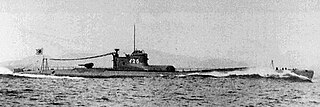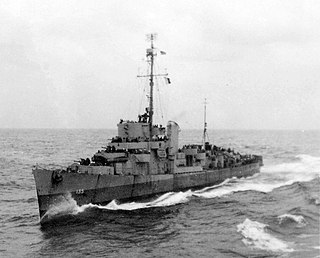
USS Bogue (AVG/ACV/CVE/CVHE-9) was the lead ship in the Bogue class of escort carriers in the United States Navy during World War II. The ship was named for Bogue Sound in North Carolina.

USS Card was an American Bogue-class escort carrier that saw service in World War II. She was named for Card Sound, a continuation of Biscayne Bay, south of Miami, Florida. She was the flagship of Task Group 21.14 a hunter-killer group formed to destroy German submarines in the North Atlantic.

USS Block Island (CVE-21/AVG-21/ACV-21) was a Bogue-class escort carrier for the United States Navy during World War II. She was the first of two escort carriers named after Block Island Sound off Rhode Island and was the only American carrier sunk in the Atlantic during the war.

USS Hunt (DD-194) was a Clemson-class destroyer in the United States Navy following World War I. She also served in the United States Coast Guard, as USCGD Hunt (CG-18). She was later transferred to the Royal Navy as HMS Broadway (H90).

USS Bulmer (DD-222/AG-86) was a Clemson-class destroyer in the United States Navy during World War II. It was the last warship of the Asiatic Fleet in USN commission.

USS Sutton (DE-771) was a Cannon-class destroyer escort in service with the United States Navy from 1943 to 1948. In 1956, she was transferred to South Korea, where she served as Kang Won (F-72) until 1977. The ship was then cannibalized for spare parts in the Philippines.

The Type B1 submarine, also called I-15-class submarine was the first group of boats of the Type B cruiser submarines built for the Imperial Japanese Navy (IJN) during the 1940s. In total 20 were built, starting with I-15, which gave the series their alternative name.

USS Hubbard (DE-211/APD-53) was a Buckley-class destroyer escort in service with the United States Navy from 1944 to 1946. She was scrapped in 1966.

USS Robert I. Paine (DE/DER-578), a Buckley-class destroyer escort of the United States Navy, was named in honor of Marine Corps Private Robert I. Paine (1923-1942), who was killed in action during the attack on Tulagi on 7 August 1942. He was posthumously awarded the Silver Star.

USS Muir (DE-770) was a Cannon-class destroyer escort in service with the United States Navy from 1943 to 1947. In 1956, she was transferred to South Korea, where she served as Kyongki (F-71) until 1977. The ship was then cannibalized for spare parts in the Philippines.

USS Pillsbury (DE-133) was an Edsall-class destroyer escort in service with the United States Navy from 1943 to 1947. She served again as a radar picket ship from 1955 to 1960 and was sold for scrapping in 1966.

USS Pope (DE-134) was an Edsall-class destroyer escort built for the United States Navy during World War II. She served in the Atlantic Ocean and provided destroyer escort protection against submarine and air attack for Navy vessels and convoys.

USS Flaherty (DE-135) was an Edsall-class destroyer escort in service with the United States Navy from 1943 to 1946. She was sold for scrap in 1966.

USS J.R.Y. Blakely (DE-140) was an Edsall-class destroyer escort in service with the United States Navy from 1943 to 1946. She was scrapped in 1973.

USS Pride (DE-323) was an Edsall-class destroyer escort built for the U.S. Navy during World War II. She served in the Atlantic Ocean the Pacific Ocean and provided destroyer escort protection against submarine and air attack for Navy vessels and convoys. She returned home at war's end with three battle stars and then entered into service for the U.S. Coast Guard before final decommissioning.

USS Janssen (DE-396) was an Edsall-class destroyer escort in service with the United States Navy from 1943 to 1946. She was sold for scrapping in 1973.

USS Varian (DE-798) was a Buckley-class destroyer escort of the United States Navy.

Operation Teardrop was a United States Navy operation during World War II, conducted between April and May 1945, to sink German U-boats approaching the Eastern Seaboard believed to be armed with V-1 flying bombs. Germany had threatened to attack New York with V-1 flying bombs and rocket U-boats. After the war, it was determined the submarines had not been carrying either.

Destroyer Squadron 7 is a naval unit of the United States Navy stationed in Singapore. It is assigned to the United States Seventh Fleet.
World War II was the first war where naval aviation took a major part in the hostilities. Aircraft carriers were used from the start of the war in Europe in looking for German merchant raiders and escorting convoys. Offensive operations began with the Norwegian campaign where British carriers supported the fighting on land.



















